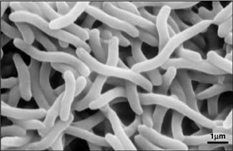The nitrogen fixation system is particularly well described, consisting of both a MoFe and an Fe-only nitrogenase. The system of post-translational regulation of nitrogenase activity is the best-understood example of reversible ADP-ribosylation as a regulatory system in any organism. This system responds to both nitrogen and energy status signals. R. rubrum is able to grow on CO as sole energy source and the CO oxidation system has been extremely well-analyzed genetically and biochemically, largely through DOE support. The structure of the CODH that lies at the heart of this system, together with analyses of its catalytic mechanism, provide a model for more complex CODHs of other organisms. The CO-oxidation regulon also contains a novel CO-sensing protein, CooA, that is becoming a paradigm for gas-sensors and transcriptional regulators. |
||
|
||
Rhodospirillum rubrum ATCC 11170

